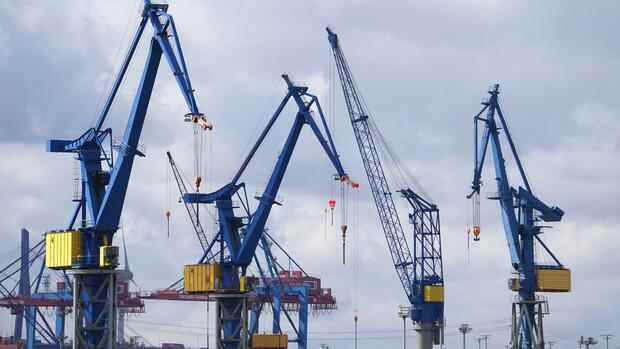The Leibniz Institute for Economic Research Halle, the German Institute for Economic Research, the Ifo Institute, the Kiel Institute for the World Economy and the RWI – Leibniz Institute for Economic Research are involved in the forecast
(Photo: dpa)
Berlin Strong growth, falling unemployment, lower national deficit: According to the leading economic institutes, the future federal government can start with an economic tailwind in its first year. The gross domestic product is expected to grow by 4.8 percent in 2022, twice as fast as this year by 2.4 percent, as the researchers announced on Thursday for their autumn forecast.
In the spring, in their joint forecast for the federal government, the institutes only forecast growth of 3.9 percent for the coming year. Because of the acute material bottlenecks in the industry, the upturn in the year to come will be a bit smaller: an increase of 3.7 percent had been expected here so far. Europe’s largest economy is expected to grow by 1.9 percent in 2023. In 2020 it had shrunk by 4.6 percent because of the Corona crisis.
“The economic situation in Germany is still characterized by the corona pandemic,” said the institutes. “A complete normalization of contact-intensive activities is not to be expected in the short term.” In addition, supply bottlenecks – for example for the semiconductors that are indispensable for the automotive industry – are hindering the industry. “In the course of 2022, the German economy should return to normal capacity,” it said.
The federal government itself confirms: The ongoing supply bottlenecks in the industry are stalling the recovery from the corona crisis. In the past summer quarter, there should have been “a noticeable increase in economic output”, according to the monthly report published on Thursday by the Ministry of Economic Affairs. “For the fourth quarter, on the other hand, there are signs of a normalization of growth.” The development will “run sideways” here, ie more or less stagnate.
Top jobs of the day
Find the best jobs now and
be notified by email.
According to a report by the economic institutes, the situation on the labor market should gradually improve. The number of people in employment in the coming year is expected to be just under 45.4 million, above the pre-crisis level and to rise again by almost 400,000 in 2023. The number of unemployed is expected to drop to 2.356 million by then, which would still be around 89,000 more than in 2019.
Inflation should fall again
The upswing is also filling the state coffers. The deficit is expected to be 173.7 billion euros or 4.9 percent of gross domestic product this year due to the corona costs, but will fall to 80.5 or 2.1 percent in 2022. 2023 could move closer to the black zero: The deficit should then decrease to 35.1 billion or 0.9 percent.
Economists expect inflation to ease. Due to higher energy prices, the rate of inflation this year, at an average of 3.0 percent, is likely to be as high as it has been in 27 years. In the coming year, however, it should fall to 2.5 percent and in 2023 to 1.7 percent.
In September consumer prices rose by 4.1 percent, the fastest they have been since 1993. This was also ensured by a number of special effects – such as the extremely low starting level for raw material prices, catch-up effects caused by pandemics and lockdowns, or the temporary VAT cut in the fight against the corona crisis in the second half of 2020. The Ministry of Economic Affairs assesses inflation in a similar way in its monthly report. The government does not expect relief until next year, when special effects expire.
The federal government uses the joint forecast as the basis for its own projections, which in turn form the basis for the tax estimate. The expert opinion is being prepared by the RWI in Essen, the DIW in Berlin, the Ifo Institute in Munich, the IfW in Kiel and the IWH in Halle.
More: IMF revises growth forecast and warns of an inflation spiral
